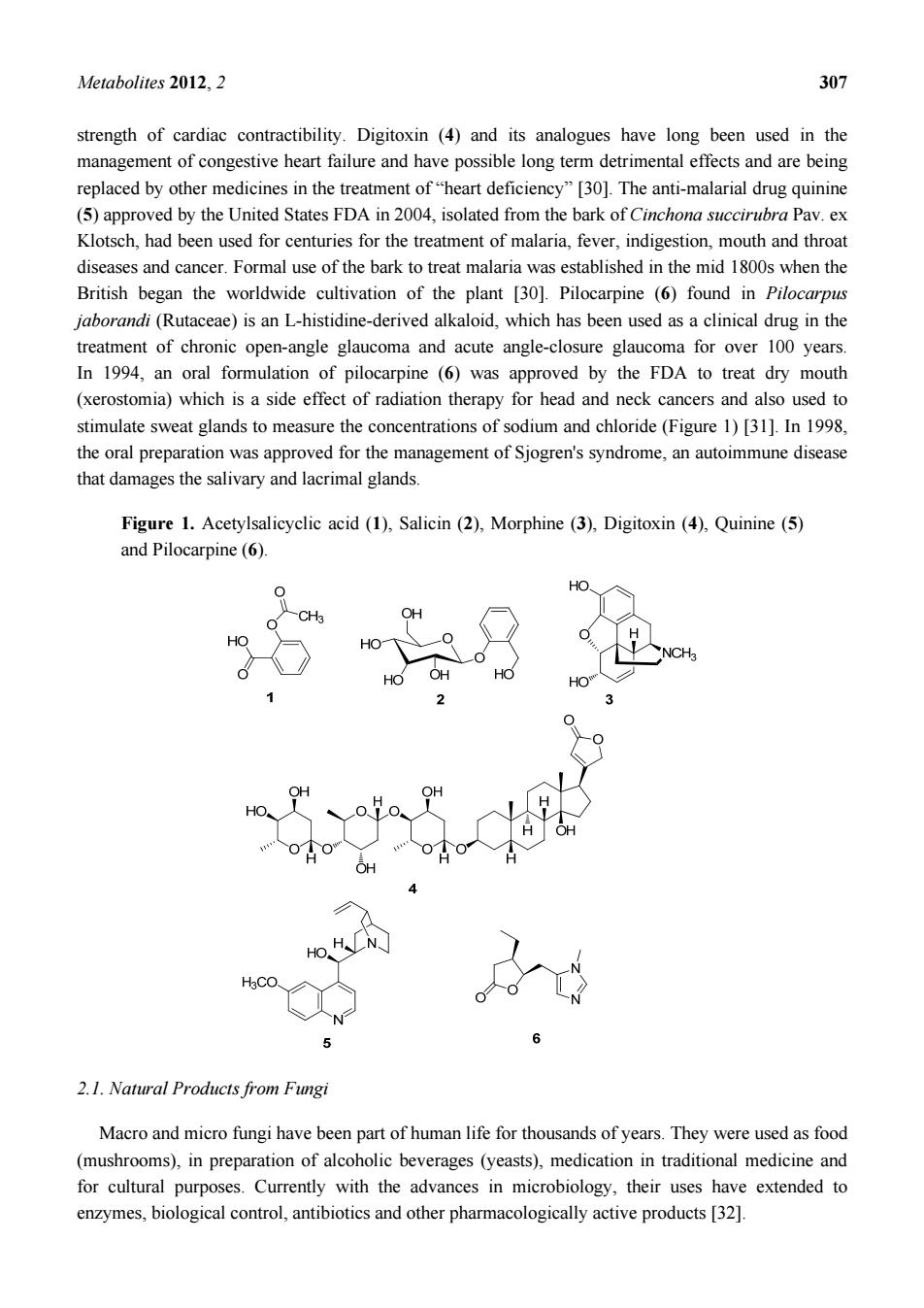正在加载图片...

Metabolites 2012.2 307 strength of cardiac contractibility.Digitoxin (4)and its analogues have long been used in the management of congestive heart failure and have possible long term detrimental effects and are being replaced by other medicines in the treatment of"heart deficiency"[30].The anti-malarial drug quinine (5)approved by the United States FDA in 2004,isolated from the bark of Cinchona succirubra Pav.ex Klotsch,had been used for centuries for the treatment of malaria,fever,indigestion,mouth and throa diseases and cancer.Formal use of the bark to treat malaria was established in the mid 1800s when the British began the worldwide cultivation of the plant [30].Pilocarpine (6)found in Pilocarpus jaborandi(Rutaceae)is an L-histidine-derived alkaloid,which has been used as a clinical drug in the treatment of chronic open-angle glaucoma and acute angle-closure glaucoma for over 100 vears In 1994,an oral formulation of pilocarpine (6)was approved by the FDA to treat dry mouth (xerostomia)which is a side effect of radiation therapy for head and neck cancers and also used to stimulate sweat glands to measure the concentrations of sodium and chloride(Figure 1)[31].In 1998. the oral preparation was approved for the management of Sjogren's syndrome,an autoimmune disease that damages the salivary and lacrimal glands. Figure 1.Acetylsalicyclic acid (1),Salicin (2),Morphine (3),Digitoxin (4).Quinine (5) and Pilocarpine(6). HO HO OH HO HO.H.CN 5 6 2.1.Natural Products from Fungi Macro and micro fungi have been part of human life for thousands of years.They were used as food (mushrooms).in preparation of alcoholic beverages (yeasts),medication in traditional medicine and for cultural purposes.Currently with the advances in microbiology,their uses have extended to enzymes,biological control,antibiotics and other pharmacologically active products [32]. Metabolites 2012, 2 307 strength of cardiac contractibility. Digitoxin (4) and its analogues have long been used in the management of congestive heart failure and have possible long term detrimental effects and are being replaced by other medicines in the treatment of “heart deficiency” [30]. The anti-malarial drug quinine (5) approved by the United States FDA in 2004, isolated from the bark of Cinchona succirubra Pav. ex Klotsch, had been used for centuries for the treatment of malaria, fever, indigestion, mouth and throat diseases and cancer. Formal use of the bark to treat malaria was established in the mid 1800s when the British began the worldwide cultivation of the plant [30]. Pilocarpine (6) found in Pilocarpus jaborandi (Rutaceae) is an L-histidine-derived alkaloid, which has been used as a clinical drug in the treatment of chronic open-angle glaucoma and acute angle-closure glaucoma for over 100 years. In 1994, an oral formulation of pilocarpine (6) was approved by the FDA to treat dry mouth (xerostomia) which is a side effect of radiation therapy for head and neck cancers and also used to stimulate sweat glands to measure the concentrations of sodium and chloride (Figure 1) [31]. In 1998, the oral preparation was approved for the management of Sjogren's syndrome, an autoimmune disease that damages the salivary and lacrimal glands. Figure 1. Acetylsalicyclic acid (1), Salicin (2), Morphine (3), Digitoxin (4), Quinine (5) and Pilocarpine (6). 2.1. Natural Products from Fungi Macro and micro fungi have been part of human life for thousands of years. They were used as food (mushrooms), in preparation of alcoholic beverages (yeasts), medication in traditional medicine and for cultural purposes. Currently with the advances in microbiology, their uses have extended to enzymes, biological control, antibiotics and other pharmacologically active products [32]